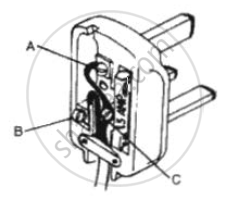Advertisements
Advertisements
प्रश्न
The following table shows the current in Amperes and potential differences in Volts.
- Find the average resistance.
- What will be the nature of the graph between the current and potential difference? (Do not draw a graph.)
- Which law will the graph prove? Explain the law.
| V (volts) | I (amp) |
| 4 | 9 |
| 5 | 11.25 |
| 6 | 13.5 |
उत्तर
From the following table,
V1 = 4V, V2 = 5V, V3 = 6V
I1 = 9 A, I2 = 11.25 A, I3 = 13.5 A
`"R"_1 = "V"_1/"I"_1 = 4/9 = 0.44 Omega`
`"R"_2 = "V"_2/"I"_2 = 5/11.25 = 0.44 Omega`
`"R"_3 = "V"_3/"I"_3 = 6/13.5 = 0.44 Omega`
| V (Volt) | I (Ampere) | R(Ω) = `bb"V"/bb"I"` |
| 4 | 9 | 0.44 |
| 5 | 11.25 | 0.44 |
| 6 | 13.5 | 0.44 |
a. Average resistance (R) = `("R"_1 + "R"_2 + "R"_3)/3`
= `(0.44 + 0.44 + 0.44)/3`
= `1.32/3 = 0.44`
∴ Average resistance (R) = 0.44 Ω
b. A straight line will pass through the origin (0, 0) on the graph between current and potential difference.
c. Here `"V"_1/"I"_1 = "V"_2/"I"_2 = "V"_3/"I"_3` i.e. Ohm's law is clear from I ∝ V.
APPEARS IN
संबंधित प्रश्न
The atoms of copper contain electrons and the atoms of rubber also contain electrons. Then why does copper conduct electricity but rubber does not conduct electricity?
A p.d. of 6 V is applied to two resistors of 3 Ω and 6 Ω connected in parallel. Calculate:
(a) the combined resistance
(b) the current flowing in the main circuit
(c) the current flowing in the 3 Ω resistor.
V1, V2 and V3 are the p.ds. across the 1Ω, 2Ω and 3Ω resistors in the following diagram, and the current is 5 A.

Which one of the columns (a) to (d) shows the correct values of V1, V2 and V3measured in volts?
`V_1` `V_2` `V_3`
(a) 1.0 2.0 3.0
(b) 5.0 10.0 15.0
(c) 5.0 2.5 1.6
(d) 4.0 4.0 2.0
What happens to the other bulbs in a series circuit if one bulb blows off?
An electrician has wired a house in such a way that if a lamp gets fused in one room of the house, all the lamps in other rooms of the house stop working. What is the defect in the wiring?
Draw a circuit diagram showing two lamps, one cell and a switch connected in series.
How can you change the brightness of the lamp?
An electric bulb is rated as 10 W, 220 V. How many of these bulbs can be connected in parallel across the two wires of 220 V supply line if the maximum current which can be drawn is 5 A?
State two differences between the e.m.f and terminal voltage of a cell.
Fig. shows a 3 pin plug with the cover removed. The electric cable
connected to the plug contains 3 wires with colour coded insulation namely brown, blue and green.

- Identify each of the colour coded wires by stating to which of the
terminals A, B or C in the diagram they should be connected. - Identify the terminal through which no current passes in normal
circumstances. - What is the purpose of the earthed wire connected to an electric
appliance like an electric heater? Describe how it works.
A bulb of 40 W is used for 12.5 h each day for 30 days. Calculate the electrical energy consumed.
State the condition when it is advantageous to connect cells in parallel.
Conventionally, the direction of the current is taken as:
Which of the following represents voltage?
The number of electrons constituting a 1-coulomb charge is ______.
